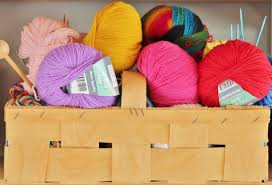Learn to Choose the Right Needlepoint Yarn for any Project
Needlepoint yarns and threads come in a wide variety of fibers, colors, textures, and weights. This basic guide describes the different options and when to use them.
The vast assortment of different yarns and threads available today can be confusing. Which ones work best for needlepoint? How should a needle pointer choose the right yarn or thread for a particular project?
It’s easier than it looks to choose the right needlepoint yarn. Start by considering what gauge canvas will be used for the project, and how the project will be used.
Match the Yarn’s Weight and Thickness to the Needlepoint Canvas
The yarn should be thin enough to slip easily through the holes in the needlepoint canvas you are using without catching or fraying, and thick enough that the canvas threads won’t show through the design. As a general rule, the lower the canvas gauge number, the heavier and thicker the yarn should be. Gauge 3 rug canvas calls for a very thick yarn, while gauge 26 silk gauze canvas needs ultra-fine silk thread.
Match the Yarn Fiber and Durability to the Project’s Intended Use
Needlepoint yarns are made from some different fibers, including wool, cotton, silk, acrylic, rayon, and metallic. Wool is the traditional favorite because it is naturally strong and comes in a rich variety of colors. Needlepoint wool yarn can last for centuries with proper treatment. Its natural durability makes it a good choice for projects that will get heavy use, such as chair seats or sofa cushions. Knitting yarn is not recommended for those projects because they are spun with shorter and softer fibers than needlepoint wool yarns, which makes them less durable.
Less sturdy options like rayon and metallic threads can work for projects that won’t regularly be handled, such as wall hangings or Christmas ornaments.
Some yarns can be separated into smaller strands to make a thinner yarn when needed. Persian needlepoint yarn has three strands, and embroidery floss has multiple strands, the exact number depending on what fiber the floss was spun from.
Most Popular Needlepoint Yarns and Threads
- Persian Yarn. An all-purpose, 3-strand wool yarn spun specifically for needlepoint in wool and acrylic. The strands can easily be separated to make thinner yarn. It’s also possible to add more strands to make a thicker yarn.
- Tapestry Yarn. This single-strand yarn spun in either wool or acrylic is slightly finer than Persian yarn. Separating tapestry yarn into thinner strands is difficult.
- Crewel Yarn. A fine single-strand yarn spun from either wool or acrylic; crewel yarn is much finer than Persian yarn. It is usually used for crewel embroidery, but can also be used as a needlepoint yarn.
- Embroidery Floss. This multiple-strand thread is available in cotton, rayon, or silk. The strands can easily be separated to produce the proper thickness for a particular project.
- Pearl Cotton. A lustrous, single-strand cotton thread used for embroidery. It can’t be parted into thinner strands. Pearl cotton is available in three weights: fine (#8), medium (#5) and heavy (#3).
- Matte Embroidery Cotton. A soft, single-strand cotton thread with a dull finish.
- Metallic Thread. Available in a variety of weights, colors, and textures. This is mainly used to highlight small areas because it doesn’t wear well.
While the yarns and threads listed here are the ones most commonly used for needlepoint, they certainly aren’t the only choices. Almost any fiber that can be threaded through a tapestry needle and will fit through the openings in the needlepoint canvas can be used for needlepoint. It might be enjoyable to try some of the gorgeous decorative knitting wools available today, ribbon, or even strips of torn fabric for projects that won’t get heavy wear.

